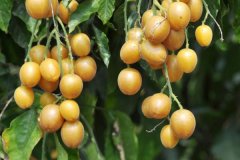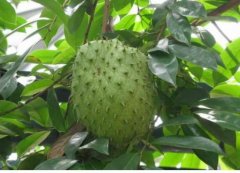What are the characteristics of guava fertility habits? Introduction of Guava Planting Technique and Pruning Method
Guava is a very common fruit in Guangdong, but in other areas, this kind of fruit is relatively rare. Let's take a look at the growth habits and planting techniques of guava. The planting method is different from that of peaches!
Growth habits of guava
Guava is a tropical fruit tree, which likes warm and humid climate. The optimum temperature for growth and fruiting is 15-32 ℃ and 23-28 ℃, respectively. Guava could not tolerate low temperature, and when the temperature dropped to 5-7 ℃, the leaves appeared the cold injury of erythema. In summer, if high temperature and rainy weather, it was easy to cause flower and fruit drop, high temperature made the fruit mature quickly, the pulp was easy to soften, and the sugar content would decrease. Guava is a shallow root crop, whose pH value is pH5.5-7.5. the soil with good drainage and rich organic matter is suitable for its growth.
Planting technology of guava
Preparation before planting: 1. Orchard land selection
Good guava orchards should be selected in areas with good drainage and shelter from the wind, followed by consideration of sunshine, water, field formation, transportation and other conditions. in addition, it is better in areas free of cold damage and soil diseases and insects and rich in organic matter. it can reduce the harm of natural disasters and improve the investment cost of the production environment.
two。 Garden planning
The orchard should be planned with wide row and close planting, the row spacing is 3.5-4 m and the plant spacing is 2.7-3.6 m. The row-plant spacing can be adjusted according to the cultivated area, soil fertility and labor. If the land is cheap and the arable land area is large, it is recommended to widen the row-plant spacing and set aside the mechanical operation road. it can increase the convenience and ventilation of spraying, fertilization and mechanical operation.
3. Irrigation and drainage
Good field water management is beneficial to the growth of guava and should be adjusted according to its growth demand, so there should be sufficient water supply for dry season irrigation in the field, and pressure motor can be set up with sprinkler irrigation or eyedropper facilities to make a uniform water supply in the whole garden. Guava is a shallow root crop, which is not resistant to flooding, so orchards with poor drainage or paddy fields can first make high beds and trench along the terrain between rows to speed up drainage, so as to avoid stagnant water in orchards affecting plant development.
4. Source and planting of seedlings
Guava seedlings are propagated asexually by grafting method or high pressure method in order to maintain the characteristics of excellent varieties. When purchasing seedlings grafting, attention should be paid to healthy seedlings with pure varieties, well-developed roots and no diseases and insect pests (especially root nodule nematodes). During the planting period, the rainy season should be avoided, the cultivator should be used to open the ditch, the plant should be planted at the edge of the ditch, a small amount of chemical fertilizer and organic fertilizer can be applied at the bottom of the planting hole, and the pillar should be fixed after planting, so as to avoid damage to the connecting position and root system caused by strong wind shaking the tree.

Colonization
Guava is usually planted in wide rows, with a row spacing of 3.5 to 4.5 meters and a plant spacing of 2.7 to 3.6 meters. The wide row is convenient for mechanical operation and the orchard is well ventilated. The planting is too dense, the ventilation is poor, the occurrence of diseases and insect pests is more serious, field management, spraying and other operations are extremely inconvenient.
The seedlings planted should be healthy seedlings with pure varieties, well-developed roots and no nodule nematodes. Easy to accumulate water in the orchard, it is appropriate to avoid planting in the rainy season, planting, can be used to trench, seedlings planted on the edge of the ditch, planting should not be too deep, as the seedlings grow, cultivate the soil step by step. Fully mature compost should be used in planting holes. After planting, set up pillars to avoid damage to the connecting parts and roots caused by strong winds. If there is a bud on the new shoot of the seedling plant, the bud should be removed as soon as possible so as not to bear fruit, so as not to affect the growth of the seedling. For a period of time after planting, if the attached plastic tape cannot split by itself, it should be cut off manually.
Guava propagation
The heart of guava fruit is pregnant with hundreds of seeds, but after ovary and pollen pollination and fertilization, its genetic factors are different from the original, but how to preserve his variety of delicious guava? Generally speaking, there are three ways to achieve asexual reproduction:
Rely on grafting: this is the most common breeding method used by seedling operators, by creating partial wounds between the root rootstock (usually tuba seedlings) and unisolated scions (commercial varieties such as Pearl), and joining the two wounds. After a month of culture, callus will be formed at the interface, which means that after the scion is isolated, it can begin to rely on the vascular bundle of the root rootstock to obtain nutrients and water.
Cutting method: cutting is to take 2-3 mature guava branches, cut in a breathable and water-retaining hairy root medium, and cultured in a high humidity environment to promote the production of adventitious roots. This method has high production efficiency, but due to the lack of main roots of cutting seedlings, there are doubts that it is easy to lodge, so the market still depends mainly on seedling grafting.
High pressure method: high pressure is to peel the tree trunk directly, then wrap the ring peeling place of orchids with soaked water moss, and then wrap the water moss with transparent plastic cloth. After about a month in summer, you can find that the surface of water moss and plastic cloth is covered with many adventitious roots.
Tree management and pruning
Tree management
Although guava can blossom one year after planting, in order to cultivate tree type, fruit thinning should be carried out in the first year and strong cutting should be avoided. The tree type with evenly distributed branches and leaves can intercept sufficient light in the leaves of guava, improve the efficiency of photosynthesis and supply the growth of fruit. In order to take into account both yield and quality, the tree type of guava is mainly natural and happy. After planting, when the trunk grows to 40-50 cm, 3-4 fully developed main branches are selected to spread around. The bracket and rope can be used to fix the tree type, so that the angle between the main branch and the trunk can be maintained at 45-60 °. After setting, it is pruned to cultivate the sub-main branch, so that the sub-main branch alternates between left and right, and then causes it to grow side branches and fruit branches.
Pruning
The purpose of pruning guava is to dwarf plants, and pruning can also promote shoot emergence and flower bud differentiation, so the pruning time can be adjusted to control the production period. The plant height of guava should be controlled at about 2 meters to facilitate fruit thinning and bagging. The principle of pruning is to evenly distribute branches and leaves, avoid overlapping shade, and cut off overgrown, overdense, withered, diseased and hanging branches near the ground. After the long branch is extracted from the sub-main branch, it does not need to be completely cut off, but can leave part of the fruit to cover the upper layer of the fruit to avoid sunburn.
Do you like this kind of fruit? After reading the above planting method, if you want to plant guava fruit trees, then act quickly!

- Prev

How to grow yellow fruit? How many varieties of yellow fruit are there? what are the planting techniques?
Huangpi fruit is also known as yellow peel, yellow orange, oil skin, oil plum, yellow marbles, chicken skin fruit, litchi grape, longan grape, standing grape, golden tree grape and so on. The variety of yellow fruit is very rich, and about 50 or 60 varieties have been found so far. There are sour, sweet or sweet varieties
- Next

What are the functions of Annona spicata? Fruit of Annona przewalskii planted for several years
Do you know what Annona looks like? What's the effect? The planting method of Annona is different from that of litchi. Is it easy to cultivate Annona? Annona przewalskii English name: Guanabana,Mountain Soursop, scientific name: An
Related
- The first cup of black tea in spring, the flavor and history of tea gardens in Kenya, Africa
- The computer can not only choose potatoes, but also grow tea rice. AI will grow winter oolong tea champion.
- It is not only the inflated tea bitten by insects, but also engraved with the four seasons tea in Beipu.
- The Oriental Beauty Tea Festival in Zhuxian County takes the stage at the weekend to experience the plus-size feast of oil tea.
- & quot; Oriental Beauty Tea & Exploration of Emei in Hsinchu, the hometown of quot;
- The new variety of strawberry "Tainong 1" dessert is the first choice with mellow aroma. Crimson gorgeous
- History of Tea in Taiwan: from Wild Inner Mountain to Export Tea Garden
- Two types of Taiwan Oriental Beauty Black Tea won the British three-Star Award for Childhood Tea Xiang Zhang Jiaqi changed from pilot to champion tea maker.
- Banana species and varieties: the planting history of Taiwan Xianren banana and dwarf banana is long, is banana disease resistant?
- Coffee planting Technology: Qianjie Coffee from Seedling to harvesting

